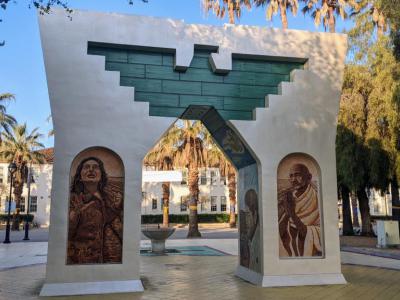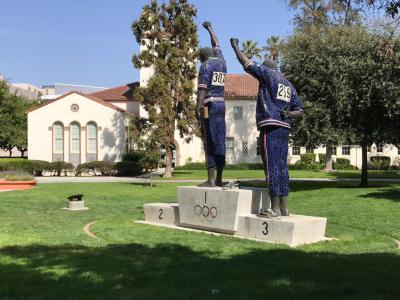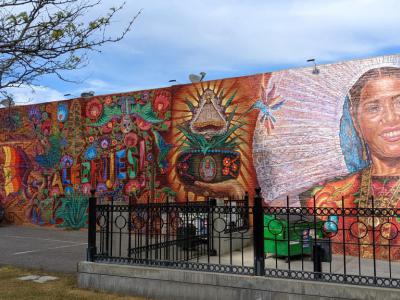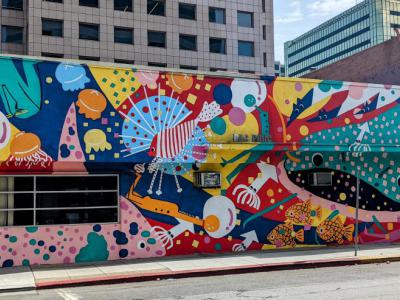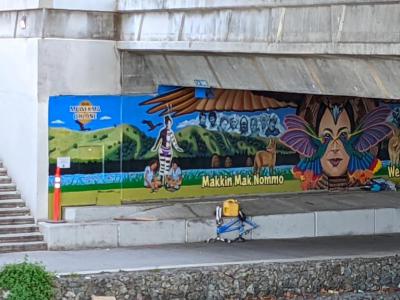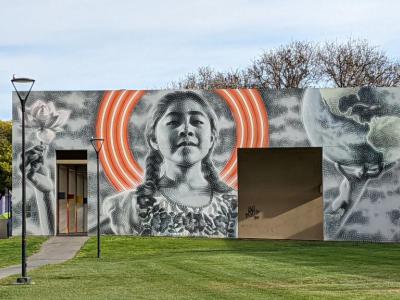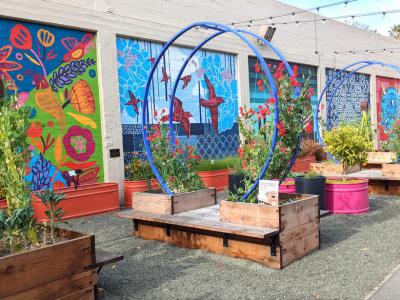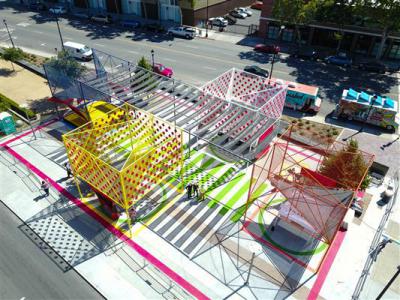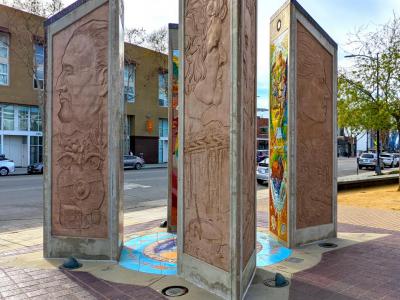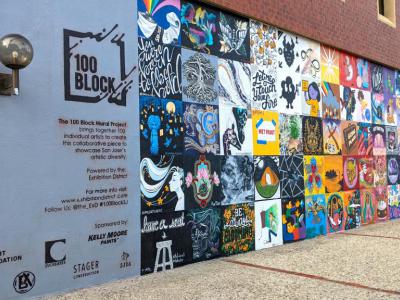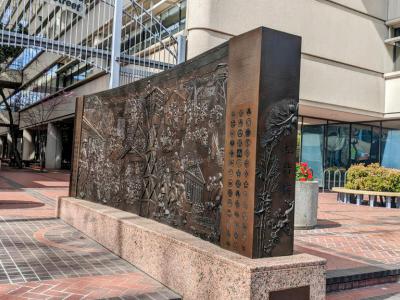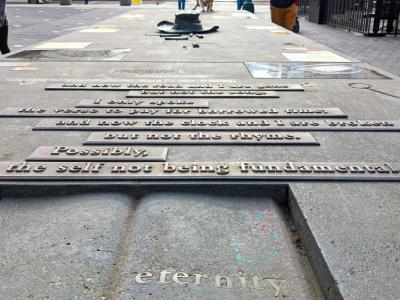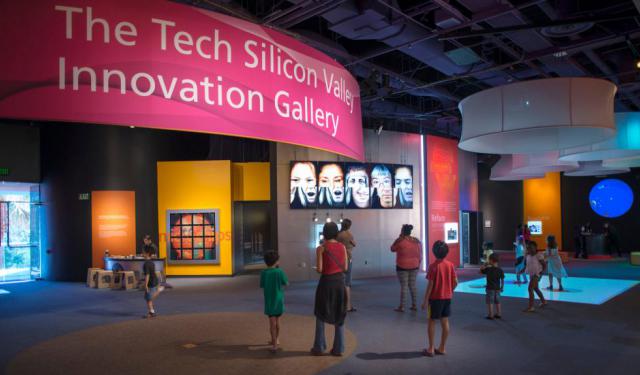San Jose Public Art Walking Tour (Self Guided), San Jose
This walking tour, “Public Art as Resistance in San José,” highlights the history of resistance and public art in downtown San José and begins on the urban university campus, San José State University. Starting from the first two works of art on campus, you’ll find that these 12 works of public art are among many in this area. However, this particular walking tour considers how San José’s communities actively challenge narrow and exclusionary interpretations of local history through public art creation, through both impermanent creations, such as graffiti murals, and more permanent large scale public sculptures, and utilize public art as a space of resistance, resisting both colonialist histories and recent narratives of urban demise through the beautification of urban space via art that showcases diversity in the city.
Monuments and public art stand as public acknowledgments to people and events woven into community and national narratives. They complement the historical perspectives that are taught within the formal education system to create a common origin story for a unified society. Narratives are not all encompassing, much like literary works their components are selected for the value of storytelling – resulting in the exclusion of the stories of all who make up the society. To resist the monolithic homogeneous narrative, monuments serve as resistance, adding new chapters to inspiration and critique. As acts of public resistance they are often framed as community beautification projects or monuments to civil rights movements, as opposed to open calls to question the dominant narrative and the absence of those groups who have been traditionally underrepresented and excluded. Art in all its forms is meant to challenge the viewer to question what they see, broadening their knowledge base to see a more holistic and complicated version of the world. These monuments ask the viewer to question their perspectives on history and be open to broadening it.
This is an abbreviated version of the walking tour created by faculty and students at San José State University in collaboration with local arts organizations. To view the full descriptions of each work of public art and learn more about the history of resistance in San José, visit the website: https://www.sjsu.edu/ha-public-art-tour/public-art
This project was made possible with support from California Humanities, a non-profit partner of the National Endowment for the Humanities. Visit www.calhum.org. Any views, findings, conclusions, or recommendations expressed in this tour do not necessarily represent those of California Humanities or the National Endowment for the Humanities.
Monuments and public art stand as public acknowledgments to people and events woven into community and national narratives. They complement the historical perspectives that are taught within the formal education system to create a common origin story for a unified society. Narratives are not all encompassing, much like literary works their components are selected for the value of storytelling – resulting in the exclusion of the stories of all who make up the society. To resist the monolithic homogeneous narrative, monuments serve as resistance, adding new chapters to inspiration and critique. As acts of public resistance they are often framed as community beautification projects or monuments to civil rights movements, as opposed to open calls to question the dominant narrative and the absence of those groups who have been traditionally underrepresented and excluded. Art in all its forms is meant to challenge the viewer to question what they see, broadening their knowledge base to see a more holistic and complicated version of the world. These monuments ask the viewer to question their perspectives on history and be open to broadening it.
This is an abbreviated version of the walking tour created by faculty and students at San José State University in collaboration with local arts organizations. To view the full descriptions of each work of public art and learn more about the history of resistance in San José, visit the website: https://www.sjsu.edu/ha-public-art-tour/public-art
This project was made possible with support from California Humanities, a non-profit partner of the National Endowment for the Humanities. Visit www.calhum.org. Any views, findings, conclusions, or recommendations expressed in this tour do not necessarily represent those of California Humanities or the National Endowment for the Humanities.
How it works: Download the app "GPSmyCity: Walks in 1K+ Cities" from Apple App Store or Google Play Store to your mobile phone or tablet. The app turns your mobile device into a personal tour guide and its built-in GPS navigation functions guide you from one tour stop to next. The app works offline, so no data plan is needed when traveling abroad.
San Jose Public Art Walking Tour Map
Guide Name: San Jose Public Art Walking Tour
Guide Location: USA » San Jose (See other walking tours in San Jose)
Guide Type: Self-guided Walking Tour (Sightseeing)
# of Attractions: 12
Tour Duration: 3 Hour(s)
Travel Distance: 6.0 Km or 3.7 Miles
Author: DanaOffice
Sight(s) Featured in This Guide:
Guide Location: USA » San Jose (See other walking tours in San Jose)
Guide Type: Self-guided Walking Tour (Sightseeing)
# of Attractions: 12
Tour Duration: 3 Hour(s)
Travel Distance: 6.0 Km or 3.7 Miles
Author: DanaOffice
Sight(s) Featured in This Guide:
- The Arch of Dignity, Equality and Justice
- Olympic Black Power Statue
- Alebrijes Mural
- Celebration Under the Water Mural
- We Are Muwekma Ohlone Mural
- Sophie Holding the World Together Mural
- SoFA Pocket Park Murals
- Urban Rooms
- Commemoration of the Founding of the Pueblo de Guadalupe
- 100 Block Mural Project
- Japanese-American Internment Memorial
- Man of Fire
1) The Arch of Dignity, Equality and Justice
Artist: Judy Baca
Year: 2008
Commissioned By: San José State University
San José State University is a downtown campus in the nation’s 10th largest city (and the 3rd largest city in the state of California). The urban landscape in the heart of Silicon Valley is unique among the 23 California State University public higher education campuses because its geography offers 27,700 undergraduate and 5,400 graduate students spanning eight colleges the experience to apply knowledge gained in the classroom to community-engaged projects. This means the city serves as an urban laboratory presenting endless opportunities for real- world knowledge and research.
Created for SJSU by renowned Chicana artist, activist and scholar, Judy Baca, the arch commemorates Mexican-American labor leader and civil rights activist Cesar Chavez through images of his life and work. The structure is based on a Mayan corbelled arch design with Spanish and indigenous roots and features mosaic tile murals. The exterior pillars depict Dolores Huerta, co-founder of the United Farm Workers, and Mahatma Gandhi, whose philosophy of non-violence was an inspiration to Chavez are presented as two pillars for the work of the United Farm Workers Union, which is represented at the top of the arch through it’s symbol- the eagle.
The opposite side pillars depict a male and female farm worker from the Salinas Valley, while the interior of the arch is dedicated to a portrait of Chavez, a nod from Baca to the activist’s humble nature. The Virgin of Guadalupe symbolically blesses Chavez’s actions, while a skull represents the deaths of farm workers from pesticides.
Placed adjacent to the Student Union building and off of an important pedestrian passageway, the Arch is designed to be circumambulated and entered. For Baca, as students and visitors to SJSU move through the arch and learn of Chavez and his work, their own bodies are symbolically transformed from witnesses to activists.
“The Arch of Dignity, Equality, and Justice,” is a reminder that the work to achieve dignity, equality and justice is often borne by those who have been denied those basic human rights. The Mahatma Gandhi inclusion traces the genealogy of resistance against those forces that denied the parity of respect to all human beings over the course of the century. Resistance to the denial of civil and human rights is referenced by the presence of Dolores Huerta, who with Cesar Chavez led the United Farm Workers in their struggle for equal rights.
The United Farm Workers symbol of the eagle is a reference to the work of the organization as well as a reminder of the connection between the Indigneous peoples of California and Mexico. We invite you to walk through the arch as a symbolic starting point for your journey through this walking tour. The next public artwork will be right in front of you.
Year: 2008
Commissioned By: San José State University
San José State University is a downtown campus in the nation’s 10th largest city (and the 3rd largest city in the state of California). The urban landscape in the heart of Silicon Valley is unique among the 23 California State University public higher education campuses because its geography offers 27,700 undergraduate and 5,400 graduate students spanning eight colleges the experience to apply knowledge gained in the classroom to community-engaged projects. This means the city serves as an urban laboratory presenting endless opportunities for real- world knowledge and research.
Created for SJSU by renowned Chicana artist, activist and scholar, Judy Baca, the arch commemorates Mexican-American labor leader and civil rights activist Cesar Chavez through images of his life and work. The structure is based on a Mayan corbelled arch design with Spanish and indigenous roots and features mosaic tile murals. The exterior pillars depict Dolores Huerta, co-founder of the United Farm Workers, and Mahatma Gandhi, whose philosophy of non-violence was an inspiration to Chavez are presented as two pillars for the work of the United Farm Workers Union, which is represented at the top of the arch through it’s symbol- the eagle.
The opposite side pillars depict a male and female farm worker from the Salinas Valley, while the interior of the arch is dedicated to a portrait of Chavez, a nod from Baca to the activist’s humble nature. The Virgin of Guadalupe symbolically blesses Chavez’s actions, while a skull represents the deaths of farm workers from pesticides.
Placed adjacent to the Student Union building and off of an important pedestrian passageway, the Arch is designed to be circumambulated and entered. For Baca, as students and visitors to SJSU move through the arch and learn of Chavez and his work, their own bodies are symbolically transformed from witnesses to activists.
“The Arch of Dignity, Equality, and Justice,” is a reminder that the work to achieve dignity, equality and justice is often borne by those who have been denied those basic human rights. The Mahatma Gandhi inclusion traces the genealogy of resistance against those forces that denied the parity of respect to all human beings over the course of the century. Resistance to the denial of civil and human rights is referenced by the presence of Dolores Huerta, who with Cesar Chavez led the United Farm Workers in their struggle for equal rights.
The United Farm Workers symbol of the eagle is a reference to the work of the organization as well as a reminder of the connection between the Indigneous peoples of California and Mexico. We invite you to walk through the arch as a symbolic starting point for your journey through this walking tour. The next public artwork will be right in front of you.
2) Olympic Black Power Statue
Artist: Rigo 23
Year: 2005
Commissioned By: San José State University
Designed by artist, Rigo 23, this larger-than lifesize fiberglass and mosaic monument, centrally placed on San José State University’s Tower Lawn, depicts the heroic and symbolic action of two African-American athletes and San José State University alumni, Tommie Smith and John Carlos, who, during the medal ceremony for the 200-meter running final in the Olympic Stadium in Mexico City on October 16, 1968, performed the Black power salute, raising their fists in silent protest. Smith, in the first place spot and Carlos, in third, planned and executed the gesture to draw attention to injustice and inequality faced by Black Americans but were greeted with boos and threats from the audience. Rendering the iconic moment through details such as the gloved hands and shoeless feet of the two athletes, Rigo 23 shows that the gesture was not accidental but planned for maximal symbolic effect.
Reenacted at SJSU in monumental form, Smith and Carlos’s protest and call towards justice is uplifted and celebrated. The second place podium spot, left empty, invites spectators to imagine themselves alongside the two icons and to follow their example in pledging to take responsibility and action towards eradicating anti-Black racism and bias.
Clad in the colors of the nation that denied African American civil rights, Smith and Carlos took a stand to draw global attention to inequality in the United States. Portrayed larger than life, their action on the medal podium echoes the chants of “Black Lives Matter,” the continuation of work to achieve dignity, equality, and justice for all citizens of this country. The statue poses a paradox for viewers. Demonstrating the harnessing of education, self-determination, and accepting of consequences to challenge the inequities of the status quo, while located on a campus of higher education at a time when those seeking an education and independence are doing so at significant financial cost to themselves, their families, and their futures.
The work for dignity, equity, and justice has and continues to take on obstacles that are meant to slow and discourage progress. Movements for equity find support among the unsung who go without recognition. The absence of silver medal winner Peter Norman of Australia, who supported Smith and Carlos’ protest, is a reminder that all people have a responsibility to humanity to stand up against intolerance and bigotry.
As you walk to your next stop, you’ll notice two notable arts and cultural institutions, the San José Museum of Art and the Cathedral Basilica of San José. Fine arts housed in cultural institutions can create unintentional entry barriers where public art does not. Sculptures placed on sidewalks and murals found on building walls are freely critiqued by anyone at any time which in itself is a means of resistance to ticketed and invited art viewing experiences.
For the next public art, look for the restaurant Mezcal - and peek around the side of their building for a fantastic view.
Year: 2005
Commissioned By: San José State University
Designed by artist, Rigo 23, this larger-than lifesize fiberglass and mosaic monument, centrally placed on San José State University’s Tower Lawn, depicts the heroic and symbolic action of two African-American athletes and San José State University alumni, Tommie Smith and John Carlos, who, during the medal ceremony for the 200-meter running final in the Olympic Stadium in Mexico City on October 16, 1968, performed the Black power salute, raising their fists in silent protest. Smith, in the first place spot and Carlos, in third, planned and executed the gesture to draw attention to injustice and inequality faced by Black Americans but were greeted with boos and threats from the audience. Rendering the iconic moment through details such as the gloved hands and shoeless feet of the two athletes, Rigo 23 shows that the gesture was not accidental but planned for maximal symbolic effect.
Reenacted at SJSU in monumental form, Smith and Carlos’s protest and call towards justice is uplifted and celebrated. The second place podium spot, left empty, invites spectators to imagine themselves alongside the two icons and to follow their example in pledging to take responsibility and action towards eradicating anti-Black racism and bias.
Clad in the colors of the nation that denied African American civil rights, Smith and Carlos took a stand to draw global attention to inequality in the United States. Portrayed larger than life, their action on the medal podium echoes the chants of “Black Lives Matter,” the continuation of work to achieve dignity, equality, and justice for all citizens of this country. The statue poses a paradox for viewers. Demonstrating the harnessing of education, self-determination, and accepting of consequences to challenge the inequities of the status quo, while located on a campus of higher education at a time when those seeking an education and independence are doing so at significant financial cost to themselves, their families, and their futures.
The work for dignity, equity, and justice has and continues to take on obstacles that are meant to slow and discourage progress. Movements for equity find support among the unsung who go without recognition. The absence of silver medal winner Peter Norman of Australia, who supported Smith and Carlos’ protest, is a reminder that all people have a responsibility to humanity to stand up against intolerance and bigotry.
As you walk to your next stop, you’ll notice two notable arts and cultural institutions, the San José Museum of Art and the Cathedral Basilica of San José. Fine arts housed in cultural institutions can create unintentional entry barriers where public art does not. Sculptures placed on sidewalks and murals found on building walls are freely critiqued by anyone at any time which in itself is a means of resistance to ticketed and invited art viewing experiences.
For the next public art, look for the restaurant Mezcal - and peek around the side of their building for a fantastic view.
3) Alebrijes Mural
Artist: Francisco Franco
Year: 2019
Commissioned By: Mezcal Restaurant San José
The title of this work is an homage to the brightly-colored genre of Mexican folk art, originating from fever-induced dreams of Mexican artist Pedro Linares, in the early 20th-century, a central feature of the imagery contained in the mural. Franco works with a deep sense of responsibility to his traditional Mexican artistic roots, while focusing on giving back to the community through his mural work.
The restaurant, Mezcal, where the mural calls home, is named after a traditional spirit of southern Mexico, based on the fermented and aged sap of the maguey cactus. Many sacred aspects of indigenous culture are represented in this mural, connecting the building itself to a rich history which originated in Mexico, but is still alive and well, taking on new form and significance in San José today. Representing the mystical qualities of the mezcal is a 15-foot tall Nuestra Señora Immaculada de Juquila, patron goddess of the maguey plant.
The deity is depicted growing out of a bowl of black clay pottery which has its own place in the spiritual lore of the Oaxacan region. The famous black mole, which is the signature dish at the restaurant, is represented in the mural as well, visually representing in a way a secret code, one that is shared by the Zapotec people, embedded in their collective DNA, that is made manifest through their artistic and culinary traditions. This rich imagery speaks the story of the various indigineous groups from these regions in southern Mexico that live in San José, along with the owners and workers of the restaurant Mezcal.
“Alebrijes” demonstrates the maintaining and celebrating of identity in response to pressures to assimilate. The retention of identity solidifies the connection to Oaxaca forming a bridge to San José infusing it with the Zapotec culture broadening its prism of diversity. “Alebrijes” is a visual reminder of the vibrancy of Indigenous life in the modern world, that it is not something of the past. That the Zapotec are not referred to as were – of the past – rather they are – present and living in full view. The worldview of the Zapotec portrayed through the mixing of the spiritual, traditional dress and crafts open the eyes of the unfamiliar to living and thriving people who are more than a curiosity and culinary genre.
(Description by Daniel Katra, SJSU, Art 174, Fall 2021, SJSU)
Year: 2019
Commissioned By: Mezcal Restaurant San José
The title of this work is an homage to the brightly-colored genre of Mexican folk art, originating from fever-induced dreams of Mexican artist Pedro Linares, in the early 20th-century, a central feature of the imagery contained in the mural. Franco works with a deep sense of responsibility to his traditional Mexican artistic roots, while focusing on giving back to the community through his mural work.
The restaurant, Mezcal, where the mural calls home, is named after a traditional spirit of southern Mexico, based on the fermented and aged sap of the maguey cactus. Many sacred aspects of indigenous culture are represented in this mural, connecting the building itself to a rich history which originated in Mexico, but is still alive and well, taking on new form and significance in San José today. Representing the mystical qualities of the mezcal is a 15-foot tall Nuestra Señora Immaculada de Juquila, patron goddess of the maguey plant.
The deity is depicted growing out of a bowl of black clay pottery which has its own place in the spiritual lore of the Oaxacan region. The famous black mole, which is the signature dish at the restaurant, is represented in the mural as well, visually representing in a way a secret code, one that is shared by the Zapotec people, embedded in their collective DNA, that is made manifest through their artistic and culinary traditions. This rich imagery speaks the story of the various indigineous groups from these regions in southern Mexico that live in San José, along with the owners and workers of the restaurant Mezcal.
“Alebrijes” demonstrates the maintaining and celebrating of identity in response to pressures to assimilate. The retention of identity solidifies the connection to Oaxaca forming a bridge to San José infusing it with the Zapotec culture broadening its prism of diversity. “Alebrijes” is a visual reminder of the vibrancy of Indigenous life in the modern world, that it is not something of the past. That the Zapotec are not referred to as were – of the past – rather they are – present and living in full view. The worldview of the Zapotec portrayed through the mixing of the spiritual, traditional dress and crafts open the eyes of the unfamiliar to living and thriving people who are more than a curiosity and culinary genre.
(Description by Daniel Katra, SJSU, Art 174, Fall 2021, SJSU)
4) Celebration Under the Water Mural
Artist: Harumo Sato
Year: 2018
Commissioned By: POW!WOW! SAN José now SJ Walls
Produced by California-based Japanese artist, Harumo Sato, as part of the 2018 San José Walls mural program, this colorful abstract, painted on the side of the 35-year old Dac Phuc Vietnamese restaurant, is a testament to the fact that public art doesn’t have to focus on difficult histories or moments of trauma to be a site of protest and action. Playful, joyful, energetic, colorful, Sato’s work uses pattern, mythology and biomorphic forms to explore the artist’s vision for a more healthy and peaceful world, one that embraces the fact that chaos and challenges are meaningful and unescapable.
These goals are mirrored in the larger San José Walls program, which brings contemporary artists to San José yearly in a live festival of art, music and community engagement. Working with and among the community, artists create work in their unique personal styles and their chosen subject matter. The resulting murals not only enhance and brighten the experience of locals and visitors as they make their way around the city, but serve as sites of resistance to narratives of urban decay. Instead, created as accessible and highly visible art spaces, these murals invite all to consider the thriving and diverse communities that make up San José.
“Celebration Under the Water” recognizes the story of Vietnamese Americans in the Bay Area in depicting the moves beyond the narrative of the Vietnam War to show that there is more below the surface. Vibrant colors illustrate the pleasure of life that occurs beneath the turbulence of the waves above. While the focus of the historical narrative may be on the conflict and trauma from half a world away there is a broader more complex story of life, joy, chaotic order, and community. The mural challenges the viewer to resist focusing on the strife of the rough seas to see the community that can flourish when diverse peoples come together in an ecosystem of respect forming a symbiotic society.
From SJWalls: "In 2021, out of respect for the indigenous community, we updated our name to San José Walls."
As you walk to your next location, contrast the effervescence of this mural with the freeway that divides the city and elevates the automobile above the urban landscape but underpasses can be gateways too. On the other side of Highway 87 is Delmas Park, a small neighborhood, defined in part by presence of a major regional transportation, Diridon Station and the future High Speed rail terminal.
Consider the changes from the bucolic South Bay of the San Francisco Bay Area to a sequence of occupants and ultimate intensification and dominance of urbanization. The vision is to deliver a world-class expanded transportation hub that integrates smoothly into downtown San José and the surrounding community– including the planned Google transit village– providing regional and statewide transportation links. The next mural is underneath you along the river walk.
Year: 2018
Commissioned By: POW!WOW! SAN José now SJ Walls
Produced by California-based Japanese artist, Harumo Sato, as part of the 2018 San José Walls mural program, this colorful abstract, painted on the side of the 35-year old Dac Phuc Vietnamese restaurant, is a testament to the fact that public art doesn’t have to focus on difficult histories or moments of trauma to be a site of protest and action. Playful, joyful, energetic, colorful, Sato’s work uses pattern, mythology and biomorphic forms to explore the artist’s vision for a more healthy and peaceful world, one that embraces the fact that chaos and challenges are meaningful and unescapable.
These goals are mirrored in the larger San José Walls program, which brings contemporary artists to San José yearly in a live festival of art, music and community engagement. Working with and among the community, artists create work in their unique personal styles and their chosen subject matter. The resulting murals not only enhance and brighten the experience of locals and visitors as they make their way around the city, but serve as sites of resistance to narratives of urban decay. Instead, created as accessible and highly visible art spaces, these murals invite all to consider the thriving and diverse communities that make up San José.
“Celebration Under the Water” recognizes the story of Vietnamese Americans in the Bay Area in depicting the moves beyond the narrative of the Vietnam War to show that there is more below the surface. Vibrant colors illustrate the pleasure of life that occurs beneath the turbulence of the waves above. While the focus of the historical narrative may be on the conflict and trauma from half a world away there is a broader more complex story of life, joy, chaotic order, and community. The mural challenges the viewer to resist focusing on the strife of the rough seas to see the community that can flourish when diverse peoples come together in an ecosystem of respect forming a symbiotic society.
From SJWalls: "In 2021, out of respect for the indigenous community, we updated our name to San José Walls."
As you walk to your next location, contrast the effervescence of this mural with the freeway that divides the city and elevates the automobile above the urban landscape but underpasses can be gateways too. On the other side of Highway 87 is Delmas Park, a small neighborhood, defined in part by presence of a major regional transportation, Diridon Station and the future High Speed rail terminal.
Consider the changes from the bucolic South Bay of the San Francisco Bay Area to a sequence of occupants and ultimate intensification and dominance of urbanization. The vision is to deliver a world-class expanded transportation hub that integrates smoothly into downtown San José and the surrounding community– including the planned Google transit village– providing regional and statewide transportation links. The next mural is underneath you along the river walk.
5) We Are Muwekma Ohlone Mural
Artist: Alfonso Salazar
Year: 2021
Commissioned By: SJWalls
Look below the street level and underneath a bridge for this next mural. The importance of urban green spaces and multi use corridors promote healthier and safer pedestrian and cycling movements throughout the city. Well-designed public trails create spaces for active play and passive reflection, both offering respite from urban life. Parks and plazas in downtowns are used as accessible free spaces of resistance confronting spaces of power and exclusion.
Stretching along the Guadalupe River Trail, this monumental mural by artist Alfonso Salazar was painted as part of the third Artist-In-Residence program at San José Walls. The work is both a depiction of the present and past of the Muwekma Ohlone tribe and a proclamation of resistance. The group, which includes Indigenous people from across the San Francisco Bay region, was stripped of their rights in 1927, despite their continual presence in their ancestral home. This public artwork runs along Thámien Rúmmey, an ancestral site for the Muwekma Ohlone, now known as the Guadalupe River, and depicts tribal leaders, elders and the landscape and flora and fauna of the region.
Central to the mural is a portrait of Muwekma Ohlone Chairwoman Charlene Nijmeh, wearing the traditional warrior eagle headpiece of the tribe. On either side of her, floating in the clouds are portraits of the elders of the tribe, while below are children engaged in traditional activities, a symbol of the continual and continuing life and traditions of the Muwekma Ohlone people. Painted in bold letters are the words “Makkin Mak Nommo (We Are Still Here).”
Salazar and the San José Walls team worked closely with Chairwoman Nijmeh and the Muwekma Ohlone tribe to create a work of art that not only honors the history of the tribe and marks the site of the Guadalupe River, but equally serves as a statement of resistance to narratives that Indigenous communities are historical, rather than present and alive. Moreover, this work serves to beautify and revitalize the Guadalupe River Trail, thus honoring the Muwekma Ohlone through action and utilizing art as a space for community gathering and wellness.
“We Are Muwekma Ohlone” is a visual response to components of settler-colonialism, the terminal narrative and erasure and replacement. The terminal narrative justified the intentional actions of extinguishment against Indigenous people because they would cease to exist as Euro-American society populated the frontier. As those new societies took possession of the lands, the original stewards were erased through the renaming of the geography, the extermination policies of California, and the destruction of their villages.
Euro-America reimagined the story of the Bay Area casting the newcomers as the original inhabitants of the land by ignoring the history of the area prior to European settlement, framing the establishment of new settlements as the “first,” and preserving a history that cast Indigenous people as the sole aggressors in conflicts and obstacles to civilization. “We Are Muwekma Ohlone” is a reminder that the Muwekma Ohlone are integral to the history of the area, and that they are here in the present living and flourishing amongst the settler-colonial society that attempted to erase and replace them.
Year: 2021
Commissioned By: SJWalls
Look below the street level and underneath a bridge for this next mural. The importance of urban green spaces and multi use corridors promote healthier and safer pedestrian and cycling movements throughout the city. Well-designed public trails create spaces for active play and passive reflection, both offering respite from urban life. Parks and plazas in downtowns are used as accessible free spaces of resistance confronting spaces of power and exclusion.
Stretching along the Guadalupe River Trail, this monumental mural by artist Alfonso Salazar was painted as part of the third Artist-In-Residence program at San José Walls. The work is both a depiction of the present and past of the Muwekma Ohlone tribe and a proclamation of resistance. The group, which includes Indigenous people from across the San Francisco Bay region, was stripped of their rights in 1927, despite their continual presence in their ancestral home. This public artwork runs along Thámien Rúmmey, an ancestral site for the Muwekma Ohlone, now known as the Guadalupe River, and depicts tribal leaders, elders and the landscape and flora and fauna of the region.
Central to the mural is a portrait of Muwekma Ohlone Chairwoman Charlene Nijmeh, wearing the traditional warrior eagle headpiece of the tribe. On either side of her, floating in the clouds are portraits of the elders of the tribe, while below are children engaged in traditional activities, a symbol of the continual and continuing life and traditions of the Muwekma Ohlone people. Painted in bold letters are the words “Makkin Mak Nommo (We Are Still Here).”
Salazar and the San José Walls team worked closely with Chairwoman Nijmeh and the Muwekma Ohlone tribe to create a work of art that not only honors the history of the tribe and marks the site of the Guadalupe River, but equally serves as a statement of resistance to narratives that Indigenous communities are historical, rather than present and alive. Moreover, this work serves to beautify and revitalize the Guadalupe River Trail, thus honoring the Muwekma Ohlone through action and utilizing art as a space for community gathering and wellness.
“We Are Muwekma Ohlone” is a visual response to components of settler-colonialism, the terminal narrative and erasure and replacement. The terminal narrative justified the intentional actions of extinguishment against Indigenous people because they would cease to exist as Euro-American society populated the frontier. As those new societies took possession of the lands, the original stewards were erased through the renaming of the geography, the extermination policies of California, and the destruction of their villages.
Euro-America reimagined the story of the Bay Area casting the newcomers as the original inhabitants of the land by ignoring the history of the area prior to European settlement, framing the establishment of new settlements as the “first,” and preserving a history that cast Indigenous people as the sole aggressors in conflicts and obstacles to civilization. “We Are Muwekma Ohlone” is a reminder that the Muwekma Ohlone are integral to the history of the area, and that they are here in the present living and flourishing amongst the settler-colonial society that attempted to erase and replace them.
6) Sophie Holding the World Together Mural
Artist: El Mac
Year: 2018
Commissioned By: San José Museum of Modern Art, in partnership with Empire 7 Studios and the Children’s Discovery Museum
Located in the green space of Discovery Park next to Children’s Discovery Museum, this mural, created by renowned artist and muralist, El Mac, in collaboration with writer and artist, Chris Myers; the arts collective, The Propeller Group; the urban contemporary arts gallery Empire 7 Studios; The San José Museum of Art; and the Children’s Discovery Museum, “Sophie Holding the World Together,” brightens this San José urban Discovery Park and offers a striking symbol of hope and human presence that dominates the wide-open green park.
The young girl, at a colossal scale, holds in her hands the world (a globe) and a lotus flower (symbol of humble beginnings). Her arms are raised high in ritual, strength, reverence, openness and acceptance. She looks just slightly down on us (her chin ever so slightly tucked in) the imperative urgency.
The mural hums with dynamic energy; and indeed the two portals, which lead to the Children Discovery Museum’s arcade where artists and musicians often perform, welcome the public and further encourage openness and fluidity, community and culture. The child in this mural, however, is neither mythological nor fantastical, but represents a brave and self-possessed seven year-old from Los Angeles named Sophie Cruz, an American activist who advocates to protect the undocumented and fights for United States immigration reform.
Though she is an American citizen, her parents are undocumented (in contemporary terminology she is of a “mixed-status family”) and she lives, still today, in fear that ICE (Immigration and Customs Enforcement) will deport her parents back to Mexico, her family’s country of origin.
“Sophie Holding the World Together” challenges the viewer to decenter themselves and attempt to perceive the world through the eyes of a young woman. In stepping back and considering her perspective on what the world would be like if empathy were employed in immigration policies and practices. The representation of the hope of a new life and the potential to contribute to the betterment of the world is asking the viewer to resist taking the easy path in seeing immigration as an issue and not as a human experience that deserves understanding and compassion.
Place names and street names memorialize notable histories but also influence place identity. On your way to the next stop, follow Woz Way, named for Steve Wozniak co-founder of Apple, to Pierce Avenue in the historic Market-Almaden Conservation Area. This neighborhood is characterized by mostly single family Victorian homes and Craftsman bungalows dating between the late 1800s and early 1900s. Planned for an urban village in downtown the well maintained old homes sit next to contextually sensitive urban infill houses built nearly a century later.
As you near Market Street notice the transition from traditional architecture to contemporary midrise redevelopment. This added housing supply addresses the need for more housing quantity but the city struggles to offer sufficient housing affordable to all.
(Description by Adrienne Defendi, Art 174, Fall 2021, SJSU)
Year: 2018
Commissioned By: San José Museum of Modern Art, in partnership with Empire 7 Studios and the Children’s Discovery Museum
Located in the green space of Discovery Park next to Children’s Discovery Museum, this mural, created by renowned artist and muralist, El Mac, in collaboration with writer and artist, Chris Myers; the arts collective, The Propeller Group; the urban contemporary arts gallery Empire 7 Studios; The San José Museum of Art; and the Children’s Discovery Museum, “Sophie Holding the World Together,” brightens this San José urban Discovery Park and offers a striking symbol of hope and human presence that dominates the wide-open green park.
The young girl, at a colossal scale, holds in her hands the world (a globe) and a lotus flower (symbol of humble beginnings). Her arms are raised high in ritual, strength, reverence, openness and acceptance. She looks just slightly down on us (her chin ever so slightly tucked in) the imperative urgency.
The mural hums with dynamic energy; and indeed the two portals, which lead to the Children Discovery Museum’s arcade where artists and musicians often perform, welcome the public and further encourage openness and fluidity, community and culture. The child in this mural, however, is neither mythological nor fantastical, but represents a brave and self-possessed seven year-old from Los Angeles named Sophie Cruz, an American activist who advocates to protect the undocumented and fights for United States immigration reform.
Though she is an American citizen, her parents are undocumented (in contemporary terminology she is of a “mixed-status family”) and she lives, still today, in fear that ICE (Immigration and Customs Enforcement) will deport her parents back to Mexico, her family’s country of origin.
“Sophie Holding the World Together” challenges the viewer to decenter themselves and attempt to perceive the world through the eyes of a young woman. In stepping back and considering her perspective on what the world would be like if empathy were employed in immigration policies and practices. The representation of the hope of a new life and the potential to contribute to the betterment of the world is asking the viewer to resist taking the easy path in seeing immigration as an issue and not as a human experience that deserves understanding and compassion.
Place names and street names memorialize notable histories but also influence place identity. On your way to the next stop, follow Woz Way, named for Steve Wozniak co-founder of Apple, to Pierce Avenue in the historic Market-Almaden Conservation Area. This neighborhood is characterized by mostly single family Victorian homes and Craftsman bungalows dating between the late 1800s and early 1900s. Planned for an urban village in downtown the well maintained old homes sit next to contextually sensitive urban infill houses built nearly a century later.
As you near Market Street notice the transition from traditional architecture to contemporary midrise redevelopment. This added housing supply addresses the need for more housing quantity but the city struggles to offer sufficient housing affordable to all.
(Description by Adrienne Defendi, Art 174, Fall 2021, SJSU)
7) SoFA Pocket Park Murals
Artist: Multiple
Year: 2021
Commissioned By: San José Museum of Quilts & Textiles collaboration with Local Color, San José Downtown Association and Veggielution
After ambling past MACLA/Movimiento de Arte y Cultura Latino Americana, you’ll find the SoFA Pocket Park tucked away next door to the San José Museum of Quilts and Textiles in the South First arts area of downtown. This series of murals by eight invited artists focuses on textile arts from a diverse group of cultural traditions. Sponsored by Local Color SJ and the San José Museum of Quilts and Textiles at the site of the SoFA Pocket Park, a revitalized parking lot which now houses Veggielution’s urban demonstration garden, this group of murals is a site of resistance that depicts San José’s diverse communities through the lens of their textile arts.
Beginning with the challenge of depicting textiles in two-dimensional form and translating the sensory qualities of texture and material onto a brick wall surface, the artists each utilized personal style to explore their own cultural traditions. The resulting murals depict the intricate and unique aesthetics of traditional African textiles, embroidered Huipils from Mexico and Guatemala, Japanese sashiko embroidery, Navajo blankets, Hmong batik cloths, Chinese symbols, and gingham plaid from the United States.
The site functions as a beautiful and open outdoor gallery, available and accessible to all members of the public. In this way, and through the efforts of Veggielution and the surrounding cultural institutions, it serves as a site of community dialogue, engagement, and action.
The SoFA Pocket Murals, located in the South First Area of San José, are a celebration of the diversity that makes up San José. While also standing as a symbol of resistance in the face of development. As SoFA is rejuvenated, maintaining the connection to the cultural vibrancy that has been a hallmark of the community serves as a living memory that will inspire newcomers to ask questions and seek out its cultural history. Equally as important, these murals are a welcome home to those who are from here and returning, and those who are just arriving. They are an invitation to add to the breadth of diversity of the city and a guard against forgetting the past.
Right across the street, you’ll find the next two works of public art in the Parque de los Pobladores.
Year: 2021
Commissioned By: San José Museum of Quilts & Textiles collaboration with Local Color, San José Downtown Association and Veggielution
After ambling past MACLA/Movimiento de Arte y Cultura Latino Americana, you’ll find the SoFA Pocket Park tucked away next door to the San José Museum of Quilts and Textiles in the South First arts area of downtown. This series of murals by eight invited artists focuses on textile arts from a diverse group of cultural traditions. Sponsored by Local Color SJ and the San José Museum of Quilts and Textiles at the site of the SoFA Pocket Park, a revitalized parking lot which now houses Veggielution’s urban demonstration garden, this group of murals is a site of resistance that depicts San José’s diverse communities through the lens of their textile arts.
Beginning with the challenge of depicting textiles in two-dimensional form and translating the sensory qualities of texture and material onto a brick wall surface, the artists each utilized personal style to explore their own cultural traditions. The resulting murals depict the intricate and unique aesthetics of traditional African textiles, embroidered Huipils from Mexico and Guatemala, Japanese sashiko embroidery, Navajo blankets, Hmong batik cloths, Chinese symbols, and gingham plaid from the United States.
The site functions as a beautiful and open outdoor gallery, available and accessible to all members of the public. In this way, and through the efforts of Veggielution and the surrounding cultural institutions, it serves as a site of community dialogue, engagement, and action.
The SoFA Pocket Murals, located in the South First Area of San José, are a celebration of the diversity that makes up San José. While also standing as a symbol of resistance in the face of development. As SoFA is rejuvenated, maintaining the connection to the cultural vibrancy that has been a hallmark of the community serves as a living memory that will inspire newcomers to ask questions and seek out its cultural history. Equally as important, these murals are a welcome home to those who are from here and returning, and those who are just arriving. They are an invitation to add to the breadth of diversity of the city and a guard against forgetting the past.
Right across the street, you’ll find the next two works of public art in the Parque de los Pobladores.
8) Urban Rooms
Artist: Estudio Teddy Cruz + Forman
Year: 2017
Commissioned By: The City of San José’s Office of Cultural Affairs Public Art Program and Movimiento de Arte y Cultura Latino Americana (MACLA)
“Urban Room’s” structure consists of elevated “rooms” formed out of brightly colored vinyl-coated chain-link fences decorated with colored diamonds. The chain link structures sit on steel edifices, creating additional “rooms” below, shaded by the chain link latticework and black fabric canopies stretched between the sections. The result is an inviting open space adjacent to a stage used to host events and community gatherings. The shaded area and event stage transform the park into a platform for block parties, community gatherings, and organized events in San José’s arty SoFA District. Between events, there are picnic tables situated in the shaded areas, providing an informal neighborhood gathering space. Viewed from the street, the large, elevated “rooms” provide a colorful addition to the narrow strip of a park, reminiscent of colorful playground equipment.
“Urban Rooms” is a public art piece about land use and communal space adaptation in the cultural production site of downtown San José. By choosing chain link fence as a building material, the design team invites dialogue about community and spatial division. Fences are designed to separate and divide, but by lifting the fences overhead to provide shade, their function is renegotiated.
“Urban Rooms” encourages resistance of the individual in favor of a communal space. Transforming the elements that would segment people, land, and communities to features that bridge division to form a community. Decentering the concept of individual space results in an experience where the viewer becomes a participant in the critique of land tenure and use. Mimicking Indigenous villages, the structures demonstrate the interdependence between the individual and community. How neither can be whole without the other.
After walking through the space, stroll over to the corner where you’ll find the next public artwork, a bas relief sculpture.
(Description by Lindsley Britton, Art174, Fall 2021, SJSU)
Year: 2017
Commissioned By: The City of San José’s Office of Cultural Affairs Public Art Program and Movimiento de Arte y Cultura Latino Americana (MACLA)
“Urban Room’s” structure consists of elevated “rooms” formed out of brightly colored vinyl-coated chain-link fences decorated with colored diamonds. The chain link structures sit on steel edifices, creating additional “rooms” below, shaded by the chain link latticework and black fabric canopies stretched between the sections. The result is an inviting open space adjacent to a stage used to host events and community gatherings. The shaded area and event stage transform the park into a platform for block parties, community gatherings, and organized events in San José’s arty SoFA District. Between events, there are picnic tables situated in the shaded areas, providing an informal neighborhood gathering space. Viewed from the street, the large, elevated “rooms” provide a colorful addition to the narrow strip of a park, reminiscent of colorful playground equipment.
“Urban Rooms” is a public art piece about land use and communal space adaptation in the cultural production site of downtown San José. By choosing chain link fence as a building material, the design team invites dialogue about community and spatial division. Fences are designed to separate and divide, but by lifting the fences overhead to provide shade, their function is renegotiated.
“Urban Rooms” encourages resistance of the individual in favor of a communal space. Transforming the elements that would segment people, land, and communities to features that bridge division to form a community. Decentering the concept of individual space results in an experience where the viewer becomes a participant in the critique of land tenure and use. Mimicking Indigenous villages, the structures demonstrate the interdependence between the individual and community. How neither can be whole without the other.
After walking through the space, stroll over to the corner where you’ll find the next public artwork, a bas relief sculpture.
(Description by Lindsley Britton, Art174, Fall 2021, SJSU)
9) Commemoration of the Founding of the Pueblo de Guadalupe
Artist: East Los Streetscapers
Year: 1997
Commissioned By: City of San José Public Art Program
Created by Wayne Alaniz Healy and David Rivas Botello, founders of the Los Angeles based art collective East Los Streetscapers, and sculptor Alejandro De La Loza, this concrete and bronze sculpture features murals and bas-relief sculpture depicting the 1777 establishment of San José as the first civilian Spanish settlement in California. Painted in the group’s colorful signature style, which emerged from the Chicano Mural Movement of the 1960s-70’s, the murals depict the day-to-day lives of the unnamed settlers from their agricultural prowess to their adobe homes.
The “Commemoration of the Founding of Pueblo De Guadalupe San José” challenges the narrative that California was born out of the Gold Rush. Serving as a reminder that the history of European settlement in the state dates back beyond 1849. The seal of the State California bears the image of Athena, who was born fully matured from the head of Zeus. The memorial is an act of resistance to the singular narrative of American settlement, acknowledging Spanish and Mexican settlement and rule that had been present since 1697.
As you head towards the next artwork, notice the variety of small businesses along First Street. Consider how vital pedestrians are to their economic viability. Between shops, galleries, and restaurants there are several empty storefronts. Consider the economic impact Covid-19 shelter-in-place had on the vitality of this important San Jose streetscape. Downtown has felt an artistic revitalization with the Art Box Project (painted utility boxes), Downtown Doors mural project, and the Street Life project.
Year: 1997
Commissioned By: City of San José Public Art Program
Created by Wayne Alaniz Healy and David Rivas Botello, founders of the Los Angeles based art collective East Los Streetscapers, and sculptor Alejandro De La Loza, this concrete and bronze sculpture features murals and bas-relief sculpture depicting the 1777 establishment of San José as the first civilian Spanish settlement in California. Painted in the group’s colorful signature style, which emerged from the Chicano Mural Movement of the 1960s-70’s, the murals depict the day-to-day lives of the unnamed settlers from their agricultural prowess to their adobe homes.
The “Commemoration of the Founding of Pueblo De Guadalupe San José” challenges the narrative that California was born out of the Gold Rush. Serving as a reminder that the history of European settlement in the state dates back beyond 1849. The seal of the State California bears the image of Athena, who was born fully matured from the head of Zeus. The memorial is an act of resistance to the singular narrative of American settlement, acknowledging Spanish and Mexican settlement and rule that had been present since 1697.
As you head towards the next artwork, notice the variety of small businesses along First Street. Consider how vital pedestrians are to their economic viability. Between shops, galleries, and restaurants there are several empty storefronts. Consider the economic impact Covid-19 shelter-in-place had on the vitality of this important San Jose streetscape. Downtown has felt an artistic revitalization with the Art Box Project (painted utility boxes), Downtown Doors mural project, and the Street Life project.
10) 100 Block Mural Project
Artists: 100 individual artists
Year: 2019
On the side of a building, this mural, sponsored by LocalColor SJ, consists of 100 individual 3’x3’ mural tiles designed and painted by local artists. The resulting 65 feet long wall comes together as a visual tapestry of images, symbols and meanings that showcases San José’s artistic diversity and stands as an example of the non-profit’s goals of creating collaborative opportunities for local makers.
In “The 100 Block Mural” the representation of the individual and collective come together in an interdependent representation of society. Though each tile represents an individual identity, aspiration, or life, they do not exist as wholly separate works, but rather a holistic representation of the city. Metropolitan centers are portrayed as homogenous, fast paced, loud and unfamiliar spaces. “The 100 Block Mural” pushes back on the perspective to show the breadth of life, worldviews, and experiences of individuals who live, work, and recreate throughout the city. The viewer is presented with 100 stories that contribute to the epic that is San José.
Which one represents your story?
The next public art tells the complex story of the Japanese-American internment in California and is a bronze sculpture tucked into a federal building plaza, behind the VTA Light Rail guard, and across from a parking structure. Plan to spend some time here taking in the representative stories on this work.
Year: 2019
On the side of a building, this mural, sponsored by LocalColor SJ, consists of 100 individual 3’x3’ mural tiles designed and painted by local artists. The resulting 65 feet long wall comes together as a visual tapestry of images, symbols and meanings that showcases San José’s artistic diversity and stands as an example of the non-profit’s goals of creating collaborative opportunities for local makers.
In “The 100 Block Mural” the representation of the individual and collective come together in an interdependent representation of society. Though each tile represents an individual identity, aspiration, or life, they do not exist as wholly separate works, but rather a holistic representation of the city. Metropolitan centers are portrayed as homogenous, fast paced, loud and unfamiliar spaces. “The 100 Block Mural” pushes back on the perspective to show the breadth of life, worldviews, and experiences of individuals who live, work, and recreate throughout the city. The viewer is presented with 100 stories that contribute to the epic that is San José.
Which one represents your story?
The next public art tells the complex story of the Japanese-American internment in California and is a bronze sculpture tucked into a federal building plaza, behind the VTA Light Rail guard, and across from a parking structure. Plan to spend some time here taking in the representative stories on this work.
11) Japanese-American Internment Memorial
Artist: Ruth Asawa
Year: 1994
Created by Japanese American modernist sculptor Ruth Asawa, this memorial, located outside of the Federal Building, commemorates the forced removal and incarceration of Japanese and Japanese-American residents of California during WWII. Sculpted in bas-relief bronze, the memorial depicts key aspects of the Japanese American experience, before and after the WWII with a central focus on the experience of the incarcerated Japanese Americans during the war.
The mural includes scenes of immigration, community life and agricultural labor and alongside symbols of the incarceration camps, including barracks, barbed wire, a watch tower, and heavily armed soldiers. The whole is accompanied by text panels that include Executive Order no. 9066 by which relocation to internment was ordained, maps of internment camps, and other historical documents. A native Californian, Asawa herself, spent four years at an internment camp in Rohwer, Arkansas along with her family.
While the memorial symbolically commemorates the experience of all Japanese Americans, it has a special poignancy in San José, whose thriving Japanese and Japanese- American community experienced forced removal, incarceration and loss of property as a result of Executive Order no. 9066. Moreover, On May 24 and 25, 1942, San José State University served as a registration site for local residents of Japanese descent prior to their forced removal and incarceration.
The “Japanese Internment Memorial” pushes the view to resist the urge to assign the injustices of the past to the yellowed pages of history. Memorializing the relocation and removal of Japanese Americans during World War II serves as an inflection point for considering the treatment of different groups today – where there is a failure to extend dignity, equality, and justice. The placement of the memorial at the Federal Building recalls the actions of the United States government to act without dignity, equality, and justice and serves as a permanent protest against the violation of civil and human rights.
Make your way by the Plaza de Cesar Chavez, a few other works of public art, and The Tech Museum to see our next interesting artwork located on Paseo de San Antonio, one of the most used passages in downtown. The paseo serves as a focal point for dining, events and theater.
Year: 1994
Created by Japanese American modernist sculptor Ruth Asawa, this memorial, located outside of the Federal Building, commemorates the forced removal and incarceration of Japanese and Japanese-American residents of California during WWII. Sculpted in bas-relief bronze, the memorial depicts key aspects of the Japanese American experience, before and after the WWII with a central focus on the experience of the incarcerated Japanese Americans during the war.
The mural includes scenes of immigration, community life and agricultural labor and alongside symbols of the incarceration camps, including barracks, barbed wire, a watch tower, and heavily armed soldiers. The whole is accompanied by text panels that include Executive Order no. 9066 by which relocation to internment was ordained, maps of internment camps, and other historical documents. A native Californian, Asawa herself, spent four years at an internment camp in Rohwer, Arkansas along with her family.
While the memorial symbolically commemorates the experience of all Japanese Americans, it has a special poignancy in San José, whose thriving Japanese and Japanese- American community experienced forced removal, incarceration and loss of property as a result of Executive Order no. 9066. Moreover, On May 24 and 25, 1942, San José State University served as a registration site for local residents of Japanese descent prior to their forced removal and incarceration.
The “Japanese Internment Memorial” pushes the view to resist the urge to assign the injustices of the past to the yellowed pages of history. Memorializing the relocation and removal of Japanese Americans during World War II serves as an inflection point for considering the treatment of different groups today – where there is a failure to extend dignity, equality, and justice. The placement of the memorial at the Federal Building recalls the actions of the United States government to act without dignity, equality, and justice and serves as a permanent protest against the violation of civil and human rights.
Make your way by the Plaza de Cesar Chavez, a few other works of public art, and The Tech Museum to see our next interesting artwork located on Paseo de San Antonio, one of the most used passages in downtown. The paseo serves as a focal point for dining, events and theater.
12) Man of Fire
Artist: Kim Yasuda
Year: 1998
Commissioned By: City of San José Public Art Program
On a paseo between two buildings, you’ll find a long table – it’s public art!
Kim Yasuda’s site-specific work honors Dr. Ernesto Galarza, a scholar, activist, community organizer and civic leader. The table is made of cast bronze and the objects on the table, such as a hat, book, and farm tools were created with inlaid bronze. The large library table is the “centerpiece” of the work, and references Dr. Ernesto Galarza’s interests in academics and labor organizing.
The importance of family to Galarza is represented by the banquet size of the library table and the arrangement of the photos and texts. The single chair at the head of the table is bronze with a wooden seat facing west towards Cesar Chavez Plaza representing his balance as a field worker and scholar. Lesser known than the table and chair: there are paved Ribbons of Terrazzo, which have bronze texts in Spanish and English with personal notes about Dr. Galarza from family, friends, and colleagues.
“Man on Fire” captures the influence of place and the individual on each other. Dr. Galarza’s work was framed in the geography of the San Joaquin Valley and the division between white and Mexican farm workers. His work also transformed the place from one of division to cooperation that laid the groundwork for the introduction of Mexican history to the schools. “Man on Fire” resists the separation of place and the individual to show the symbiotic relationship at work and his role in the formation of both.
After you experience the history of the neighborhoods and the urban environment on our walking tour, you can visit all of the vibrant, rich downtown San José public artwork with maps from “Public Art San José Downtown,” including other public art initiatives Downtown Doors, Art Box Project San José, and Street Life. Thank you for joining us on this walk. We look forward to hearing from you and recommend checking back often on the website to see other walking tours in the future: https://www.sjsu.edu/ha-public-art-tour/index.php
(Description by Caitlin Pambid, Art 174, Fall 2021, SJSU)
Year: 1998
Commissioned By: City of San José Public Art Program
On a paseo between two buildings, you’ll find a long table – it’s public art!
Kim Yasuda’s site-specific work honors Dr. Ernesto Galarza, a scholar, activist, community organizer and civic leader. The table is made of cast bronze and the objects on the table, such as a hat, book, and farm tools were created with inlaid bronze. The large library table is the “centerpiece” of the work, and references Dr. Ernesto Galarza’s interests in academics and labor organizing.
The importance of family to Galarza is represented by the banquet size of the library table and the arrangement of the photos and texts. The single chair at the head of the table is bronze with a wooden seat facing west towards Cesar Chavez Plaza representing his balance as a field worker and scholar. Lesser known than the table and chair: there are paved Ribbons of Terrazzo, which have bronze texts in Spanish and English with personal notes about Dr. Galarza from family, friends, and colleagues.
“Man on Fire” captures the influence of place and the individual on each other. Dr. Galarza’s work was framed in the geography of the San Joaquin Valley and the division between white and Mexican farm workers. His work also transformed the place from one of division to cooperation that laid the groundwork for the introduction of Mexican history to the schools. “Man on Fire” resists the separation of place and the individual to show the symbiotic relationship at work and his role in the formation of both.
After you experience the history of the neighborhoods and the urban environment on our walking tour, you can visit all of the vibrant, rich downtown San José public artwork with maps from “Public Art San José Downtown,” including other public art initiatives Downtown Doors, Art Box Project San José, and Street Life. Thank you for joining us on this walk. We look forward to hearing from you and recommend checking back often on the website to see other walking tours in the future: https://www.sjsu.edu/ha-public-art-tour/index.php
(Description by Caitlin Pambid, Art 174, Fall 2021, SJSU)
Walking Tours in San Jose, California
Create Your Own Walk in San Jose
Creating your own self-guided walk in San Jose is easy and fun. Choose the city attractions that you want to see and a walk route map will be created just for you. You can even set your hotel as the start point of the walk.
San Jose Downtown Walking Tour
San Jose is California's third-largest city and the second-largest city in Northern California. From 1849 to 1851, San Jose served as the state's first capital, which is still a local source of pride. The city has formally incorporated in 1850 and has been a center of innovation from the late 19th century, starting with agriculture and food processing.
During World War II, several... view more
Tour Duration: 1 Hour(s)
Travel Distance: 1.9 Km or 1.2 Miles
During World War II, several... view more
Tour Duration: 1 Hour(s)
Travel Distance: 1.9 Km or 1.2 Miles
San Jose Museums Tour
The capital of Silicon Valley, San Jose is full of discovery and innovation. Also, steeped in history – established since 1777 – the city has born witness to numerous chapters of American past. When it comes to culture, education and recreation, the local museums are a perfect destination for solo adventurers new to the area.
Here, among other things, you can:
- get hands-on with... view more
Tour Duration: 2 Hour(s)
Travel Distance: 3.9 Km or 2.4 Miles
Here, among other things, you can:
- get hands-on with... view more
Tour Duration: 2 Hour(s)
Travel Distance: 3.9 Km or 2.4 Miles
The Most Popular Cities
/ view all



